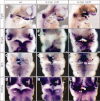Asymmetric requirement of surface epithelial β-catenin during the upper and lower jaw development
- PMID: 22354888
- PMCID: PMC3308359
- DOI: 10.1002/dvdy.23755
Asymmetric requirement of surface epithelial β-catenin during the upper and lower jaw development
Abstract
Background: Intercellular communication between epithelial and mesenchymal cells is central to mammalian craniofacial development. β-catenin is the gateway of canonical Wnt signaling, one of the major evolutionarily conserved cell-cell communication pathways in metazoa. In this study, we report an unexpected stage- and tissue-specific function of β-catenin during mammalian jaw development.
Results: Using a unique mouse genetic tool, we have discovered that epithelial β-catenin is essential for lower jaw formation, while attenuation of β-catenin is required for proper upper jaw development. Changes in β-catenin in vivo alter major epithelial Fgf8, Bmp4, Shh, and Edn1 signals, resulting in partial transcriptional reprogramming of the neural crest-derived mesenchyme, the primary source of jawbones.
Conclusions: The Wnt/β-catenin signal coordinates expression of multiple epithelial signals and has stage-specific asymmetric functions during mammalian upper and lower jaw development. In addition, these findings suggest that evolutionary changes of the canonical Wnt/β-catenin signaling pathway may lead to innovation of jaws.
Copyright © 2012 Wiley Periodicals, Inc.
Figures








Similar articles
-
Distinct populations within Isl1 lineages contribute to appendicular and facial skeletogenesis through the β-catenin pathway.Dev Biol. 2014 Mar 1;387(1):37-48. doi: 10.1016/j.ydbio.2014.01.001. Epub 2014 Jan 11. Dev Biol. 2014. PMID: 24424161 Free PMC article.
-
Wnt/β-catenin signaling in the dental mesenchyme regulates incisor development by regulating Bmp4.Dev Biol. 2010 Dec 1;348(1):97-106. doi: 10.1016/j.ydbio.2010.09.009. Epub 2010 Sep 27. Dev Biol. 2010. PMID: 20883686 Free PMC article.
-
The canonical Wnt/β-catenin signaling pathway regulates Fgf signaling for early facial development.Dev Biol. 2011 Jan 15;349(2):250-60. doi: 10.1016/j.ydbio.2010.11.004. Epub 2010 Nov 9. Dev Biol. 2011. PMID: 21070765
-
Deciphering the function of canonical Wnt signals in development and disease: conditional loss- and gain-of-function mutations of beta-catenin in mice.Genes Dev. 2008 Sep 1;22(17):2308-41. doi: 10.1101/gad.1686208. Genes Dev. 2008. PMID: 18765787 Free PMC article. Review.
-
Wakayama Symposium: Epithelial-mesenchymal interaction regulates tissue formation and characteristics: insights for corneal development.Ocul Surf. 2012 Oct;10(4):217-20. doi: 10.1016/j.jtos.2012.07.007. Epub 2012 Jul 25. Ocul Surf. 2012. PMID: 23084142 Review.
Cited by
-
The Mandibular and Hyoid Arches-From Molecular Patterning to Shaping Bone and Cartilage.Int J Mol Sci. 2021 Jul 14;22(14):7529. doi: 10.3390/ijms22147529. Int J Mol Sci. 2021. PMID: 34299147 Free PMC article. Review.
-
MicroRNA-124-3p suppresses mouse lip mesenchymal cell proliferation through the regulation of genes associated with cleft lip in the mouse.BMC Genomics. 2019 Nov 14;20(1):852. doi: 10.1186/s12864-019-6238-4. BMC Genomics. 2019. PMID: 31727022 Free PMC article.
-
Identification of a face enhancer reveals direct regulation of LIM homeobox 8 (Lhx8) by wingless-int (WNT)/β-catenin signaling.J Biol Chem. 2014 Oct 31;289(44):30289-30301. doi: 10.1074/jbc.M114.592014. Epub 2014 Sep 4. J Biol Chem. 2014. PMID: 25190800 Free PMC article.
-
Intercellular Genetic Interaction Between Irf6 and Twist1 during Craniofacial Development.Sci Rep. 2017 Aug 2;7(1):7129. doi: 10.1038/s41598-017-06310-z. Sci Rep. 2017. PMID: 28769044 Free PMC article.
-
Dkk1 in the peri-cloaca mesenchyme regulates formation of anorectal and genitourinary tracts.Dev Biol. 2014 Jan 1;385(1):41-51. doi: 10.1016/j.ydbio.2013.10.016. Dev Biol. 2014. PMID: 24479159 Free PMC article.
References
-
- Abzhanov A, Protas M, Grant BR, Grant PR, Tabin CJ. Bmp4 and morphological variation of beaks in Darwin's finches. Science. 2004;305:1462–1465. - PubMed
-
- Beverdam A, Merlo GR, Paleari L, Mantero S, Genova F, Barbieri O, Janvier P, Levi G. Jaw transformation with gain of symmetry after Dlx5/Dlx6 inactivation: mirror of the past? Genesis. 2002;34:221–227. - PubMed
-
- Brault V, Moore R, Kutsch S, Ishibashi M, Rowitch DH, McMahon AP, Sommer L, Boussadia O, Kemler R. Inactivation of the beta-catenin gene by Wnt1-Cre-mediated deletion results in dramatic brain malformation and failure of craniofacial development. Development. 2001;128:1253–1264. - PubMed
-
- Brito JM, Teillet MA, Le Douarin NM. Induction of mirror-image supernumerary jaws in chicken mandibular mesenchyme by Sonic Hedgehog-producing cells. Development. 2008;135:2311–2319. - PubMed
Publication types
MeSH terms
Substances
Grants and funding
LinkOut - more resources
Full Text Sources
Molecular Biology Databases

